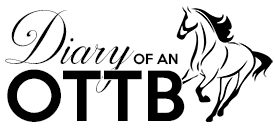I really enjoy doing groundwork with my off-track Thoroughbred. Not only does it give us some good warm-up time but it also gives me a few moments to figure out what kind of mental state my horse is in before I jump in the saddle.
Groundwork is a deceptively powerful tool for communicating with our horses and one question I frequently wonder is whether or not this work on the ground translates under saddle. With a few months of experimentation under my belt, I’m pretty confident the answer is yes, it does translate, with one major caveat that hinges on how and why you’re doing groundwork.
What is “groundwork”?
In using the word “groundwork” I’m referring to much more than lunging my horse in circles in an effort to tire him out or get the proverbial sh*ts and giggles out before I ride. If you’re approaching groundwork as only lunging, you’re limiting yourself in what you’re able to accomplish on the ground. More importantly, good luck trying to tire out an animal that’s genetically bred to wander some 20 odd miles in a day.
Groundwork, in my loose amateur-ish estimation, can encompass a whole mess of exercises and skill development on the ground, including:
- Desensitizing exercises
- Testing for appropriate responses to pressure
- Gaining focus and increasing the clarity of communication
- Creating opportunities for the horse to safely (and respectfully) play, investigate, overcome fears
- Working with obstacles and unfamiliar objects
- Yielding each front and each hind quarter with as little pressure as possible
- Stretching and flexing
- Practice backing up, changing directions, and transitions between gaits
If you’ll notice there’s one commonly used equestrian vocabulary word I haven’t included in this list: lunging. Lunging is not the end all be all of groundwork. In fact, I try to avoid encouraging my horse to run circles without paying attention to me. I’m looking for quite the opposite when we’re working on the ground — attention and respect.
One of the best instructors in this kind of teaching is Pat Parelli. I’ve seen him a handful of times at horse expos in Harrisburg, PA and Springfield, MA and each time I watch him I learn something new. I have another “A ha!” moment. Take a look at this example of “groundwork” with him and a horse named Mango.
It’s a far cry from the typical pattern of lunging in circles that you’re probably used to seeing.
But How Does This All Relate to Riding?
If you take a look at some of the exercises that I incorporate during groundwork, most of those tools can translate to positive progress in the saddle. Desensitizing and working on appropriate responses to pressure are equally useful skills to have both in the saddle and on the ground.
In looking back at some of the work I’ve put in with my OTTB on the ground, some of the most beneficial skills we’ve worked on is the ability to yield the fore and hindquarters of your horse. This directly translates to how well your horse responds to leg pressure when you’re riding. And if you’ve never had a riding instructor yell “LEG!” to you, then I’m going to go out on a limb here and suggest that you take some more lessons.
Teaching your horse how to appropriately respond to pressure and how to yield each corner of their body is a tremendously helpful skill that all starts from the ground up. It’s really difficult to teach this skill in the saddle but it’s an incredibly approachable exercise from the ground. Working on yields and backing up will have a direct correlation to how your horse responds to leg pressure and cues from the reins, how well they bend their body through a turn, and in some cases (like mine) how we’ll you’re able to steer.
Having these responses already “programmed” into your horse before you get in the saddle is a tremendous advantage and that, really, is the biggest benefit of groundwork. It gives you an opportunity to work on this programming whenever you revisit the subject and test out your horse.
So the big takeaways here? What are you practicing groundwork for and how are you practicing? Put purpose behind your groundwork and the question of whether this work will translate into the saddle will answer itself in the form of progress. Happy trails, everyone!


Your blog is saving my life. Thank you! I was about to give up. So much negative feedback…and here you are. Read your “first day with Indy” piece. Going to start there and catch up as I progress. Not new to horses, not professional either. Had a long hiatus, my new guy had me worried, sleepless and fretting. This gives me hope.